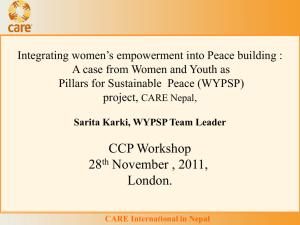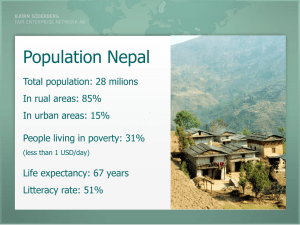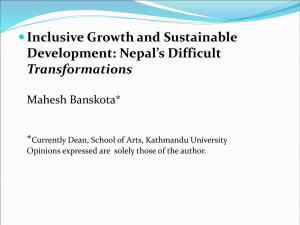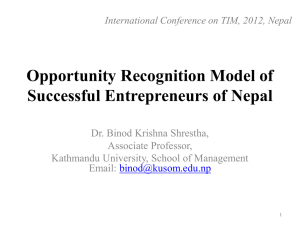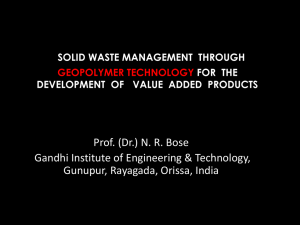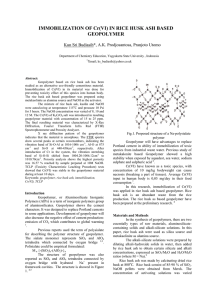Presentation - International Conference on Technology
advertisement
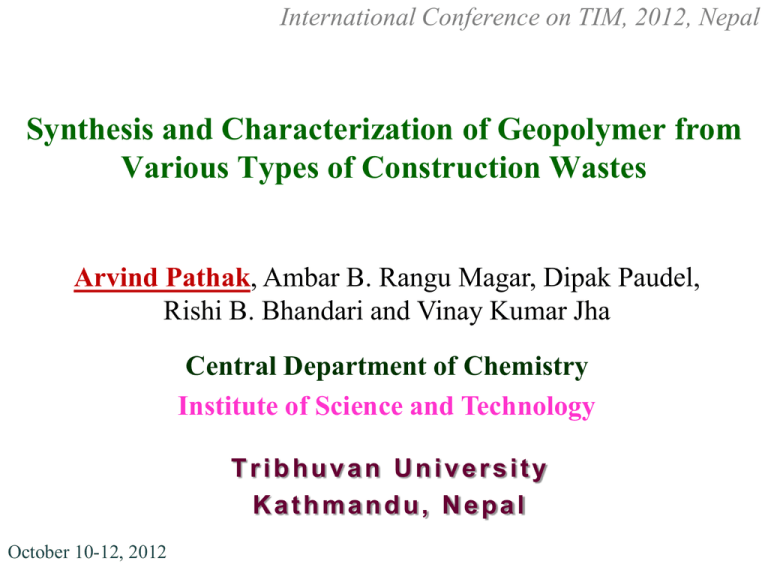
International Conference on TIM, 2012, Nepal Synthesis and Characterization of Geopolymer from Various Types of Construction Wastes Arvind Pathak, Ambar B. Rangu Magar, Dipak Paudel, Rishi B. Bhandari and Vinay Kumar Jha Central Department of Chemistry Institute of Science and Technology Tribhuvan University Kathmandu, Nepal October 10-12, 2012 International Conference on TIM, 2012, Nepal Abstract Construction wastes such as coal fly ash (CFA), demolished cement-sand-mixture (DCSM), demolished cement sand-concrete mixture (DCSCM), brick dust (BD) are rich sources of aluminosilicate and thus can be used as raw material for the synthesis of geopolymer. Geopolymers have been synthesized from construction wastes using alkali and alkali-silicate as activators. Geopolymerization can transform a wide range of alumino-silicate materials into building materials with excellent physicochemical properties such as fire, acid and earthquake resistant. Geopolymers have been synthesized from CFA, DCSM, DCSCM and BD of compressive strength 41.9, 47.0, 45.5 and 60.0 MPa respectively. 2 International Conference on TIM, 2012, Nepal Introduction Geopolymer is a class of synthetic aluminosilicate materials. It has a number of potential uses in several areas but predominantly as replacement of cement. The name “GEOPOLYMER” was first given to these materials by Prof. John Davidovits in 1970. The existence of geopolymer can be seen in Egypt’s famous Pyramids. Roman cement and small artifacts, which were previously thought to be stone, were made using the knowledge of geopolymer techniques. 3 International Conference on TIM, 2012, Nepal Some Features of Geopolymer Ceramics Concrete sleepers Paver Land slide stabilization Precast structural pipes Hazardous waste encapsulation 4 International Conference on TIM, 2012, Nepal Geopolymer and Portland cement 5 International Conference on TIM, 2012, Nepal Geopolymer and Portland cement Hardening of Portland cement (P.C.) through simple hydration of calcium silicate into calcium di-silicate hydrate and lime Ca(OH)2. Hardening of Geopolymer resin (GP) through polycondensation of potassium oligo-(sialate-siloxo) into potassium poly(sialatesiloxo) cross linked network. 6 International Conference on TIM, 2012, Nepal Geopolymer and Portland cement 7 International Conference on TIM, 2012, Nepal Objectives To synthesize geopolymer from the construction waste with comparable compressive strength like ordinary cement materials. To reduce the CO2 emission in the atmosphere. To reduce the disposal problem of construction wastes. 8 International Conference on TIM, 2012, Nepal Basic Mechanism of Geopolymerization Construction Waste Sodium Silicate Sodium Hydroxide Geopolymer Smaller particle size of construction waste, sodium silicate and higher content of alkali metals enhance the dissociation and dissolution of alumino-silicate and thereby the formation of geopolymer will have positive influence. 9 International Conference on TIM, 2012, Nepal Geopolymer Structure Barboca et al., 2000 10 International Conference on TIM, 2012, Nepal Compressive Strength and XRD Pattern Measurements SLF 9 Load frame machine Bruker, D8 Advance Diffractometer 11 International Conference on TIM, 2012, Nepal XRD-Patterns S Q: Quartz Q: Quartz, S: silica, C: calcite, M: mullite, R: rutile 53 m QS 90 m C M Q R C 75 Intensity (a.u.) 75 m Intensity (a.u.) Intensity (a.u.) 53 53 m M 75 m R C 90 m Q 120 m Q 90 Q A Q 120 10 20 CuK 2 BD 30 40 10 20 30 40 CuK 2 DCSCM 50 60 Q Q 120 m 10 20 30 40 50 CuK 2 DCSM 12 60 International Conference on TIM, 2012, Nepal Comp. Strength With NaOH Variation 8 DCSCM+NaOH Compressive strength (MPa) 7 BD+NaOH CFA+KOH 6 DCSM+NaOH 5 4 3 2 1 0 0 2 4 6 8 10 NaOH concentration (M) 13 International Conference on TIM, 2012, Nepal Compressive strength (MPa) Comp. Strength With Particle Size Variation 9 8 BD DCSCM DCSM 7 6 5 4 3 2 1 0 53 75 90 Particle size (m) 120 150 14 International Conference on TIM, 2012, Nepal Compressive strength (MPa) Comp. Strength With Na2SiO3/CW ratio 45 40 35 30 25 20 15 10 5 0 DCSCM DCSM 0.5 BD CFA 1.0 1.5 1.75 2.0 Na2SiO3 to construction wastes mass ratio 15 International Conference on TIM, 2012, Nepal Comp. Strength With Curing Time Variation Compressive strength (MPa) 70 BD DCSM 60 DCSCM CFA y = 2.169x - 0.325 R² = 0.9812 (BD) 50 y = 1.461x + 10.018 R² = 0.8122 (DCSM) 40 y = 1.2284x + 8.523 R² = 0.9884 (CFA) 30 20 10 y = 1.5055x + 3.1472 R² = 0.9926 (DCSCM) 0 0 5 10 15 20 Curing time (Days) 25 30 16 International Conference on TIM, 2012, Nepal Characterization of Geopolymer Products Q CFA-based M Intensity (a.u.) S DCSM-based DCSCM-based Q 10 20 BD-based 30 40 50 60 CuK 2 17 International Conference on TIM, 2012, Nepal Conclusion The most suitable raw material for the synthesis of geopolymer is brick-dust. Geopolymeric products of compressive strength more than 40 MPa was obtained with all types of construction wastes. Furthermore, with brick dust geopolymer of 60 MPa was achieved Thus Produced geopolymer can provide better alternate for ordinary cement. This will solve the problem of disposal and hence Geopolymers could turn construction waste into wealth. 18 International Conference on TIM, 2012, Nepal Acknowledgements Associate Prof. Dr. Vinay Kumar Jha, Central Department of Chemistry, Tribhuvan University. Nepal Academy of Science and Technology (NAST) for Ph.D. Fellowship and financial support (Project 2067/68). Central Material Testing Laboratory, Institute of Engineering (IOE), Pulchowk Campus, Tribhuvan University, Kathmandu. Assoc. Prof. Dr. Lalu Prasad Paudel, Head of Central Dept. of Geology, T. U., Kirtipur, Kathmandu for his valuable help in XRay diffraction measurement of samples. Central Department of Chemistry, Tribhuvan University for providing me the necessary facilities to carry out my Doctoral study. Organizing Committee and TIM Conference-2012 Team. 19




